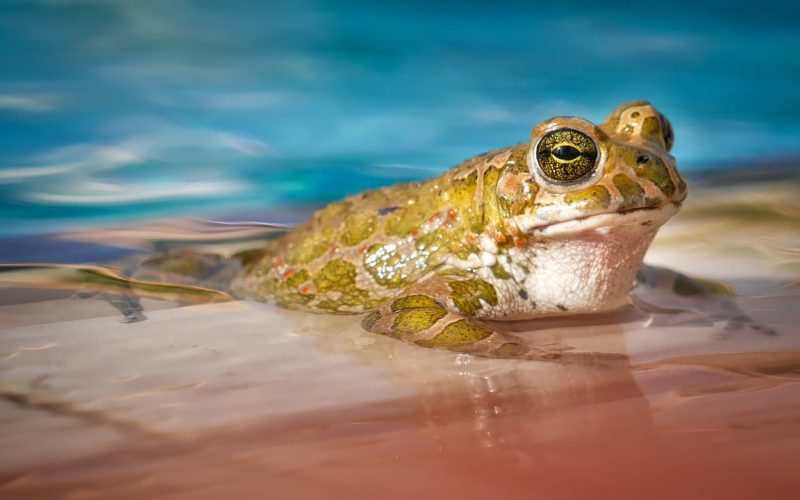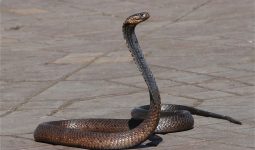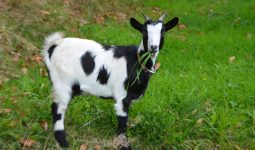Frogs are one of the most common animals you’ll find in Minnesota.
If you’re planning on getting some land, then it might be worth your while to make sure there aren’t too many frogs.
Otherwise, they’ll overpopulate and be hard to get rid of.
At the same time, you don’t want to have so few frogs that the local species of frogs go extinct because you think all frogs are pests!
So here are the types of frogs in Minnesota.
1. Bullfrog
They are one of the types of frogs in Minnesota considered an invasive species; bullfrogs are actually native to eastern North America.
In fact, bullfrog (Lithobates Catesbeianus) tadpoles are even found outside of their native range within a year or two. These giant amphibians can grow up to 8 inches long and weigh as much as 3 pounds.
Also, they’re huge eaters, too. Bullfrogs will gulp down anything they can fit into their mouths, including fish, snakes, and birds.
Bullfrog tadpoles are just as big as their adult counterparts; you’ll notice them immediately if you find yourself near a pond inhabited by these oversized frogs.
They’re a dark green color with bright yellow spots along their body. And you’ll probably be able to hear them before you see them!
2. Green Frog
The green frog (Lithobates clamitans) is one of several types of frogs in Minnesota and most are easy to spot.
They can reach up to 2 inches in length, and they’re typically green with dark spots or a yellowish coloration with red-colored dots.
When threatened, these frogs may secrete a sticky skin substance that will dry up on their body and make them harder for predators to swallow.
As adults, they feed primarily on insects such as caterpillars. When tadpoles hatch into tiny frogs, they’re voracious predators that eat other tadpoles and fish eggs.
If you want to attract more frogs to your backyard pond but don’t want green ones, look for green frogs!
3. Mink Frog
The Mink frog (Lithobates Septentrionalis) is a small, highly aquatic species that has a wide range throughout northern North America.
It can be found in most Minnesota lakes and streams during spring, summer, and fall. These creatures are very dark brown or black with scattered flecks of whitish or greenish coloration.
In addition, they are nocturnal, only emerging from hiding when it’s completely dark outside to feed on insects and other small animals like tadpoles and fish fry.
However, they do go on land sometimes to find new breeding ponds and mate. If you spot one during daylight hours, chances are it’s ill or injured (or just really lazy). These frogs generally grow to around 1-2 inches long.
4. Wood Frog
The wood frog is a highly adaptable amphibian that can live just about anywhere there’s water: streams, ponds, lakes, marshes, and even small puddles.
In fact, wood frogs can freeze solid during winter and thaw out when warmer weather comes around.
Also, they need plenty of hiding spots so they can avoid being eaten by raccoons and other predators. Wood frogs (Lithobates sylvaticus) are excellent jumpers and will spend most days hidden under rocks or logs or in holes dug into mud banks.
However, at night they come out to feed on crayfish and other invertebrates. When spring approaches (wood frogs are triggered by temperature changes), males gather in large numbers. Hundreds may be found together—to make choruses that attract females for breeding.
5. Pickerel Frog
The pickerel frog (Lithobates Palustris) has a warty back that’s brown or greenish-brown with dark blotches. It’s found throughout most of Minnesota and is known for its breeding call, which sounds like quaaak, quaaak, quaaaaaaaak.
The pickerel frog was once thought to be one of the endangered types of frogs in Minnesota but is now listed as common and widespread.
Pickerel frogs spend their winters buried below rocks or logs at the bottom of lakes and ponds.
Furthermore, when temperatures warm up enough, they come out to mate between April and July. Their tadpoles live near shore, where they grow for approximately four months before transforming into juvenile frogs.
6. Northern Leopard Frog
Northern Leopard frogs are found across most of Minnesota, but they can be hard to spot. Look for them underwater during spring and summer months and seek out shallow ponds, marshes, and wetlands.
They’re usually gray or brown in color with spots along their body.
Northern Leopard frogs (Lithobates Pipiens) are mostly harmless unless picked up by humans who are unaware.
They are unaware that these species release a toxin through their skin that can cause numbness for a few hours. If you do see one, just enjoy it from afar!
7. Eastern Gray Treefrog
The eastern gray treefrog (Hyla Versicolor) is a small frog measuring between 2 and 3 inches long. It has gray, black, or brown skin with spots or bands on its back that are darker than its belly.
This treefrog likes to live near moist forests and wooded areas. Unlike other frogs, these creatures love to climb trees and rarely come down from their treetop homes.
They have adhesive disks on their toes to help them climb trees easily. If a predator approaches these tree frogs while they’re hanging out high up on a branch, they jump off and splash into a nearby body of water.
8. Cope’s Gray Treefrog
Cope’s gray treefrog (Hyla chrysoscelis) is a small species, ranging from 1.7 to 2.2 inches (4.3-5.6 cm) long, including its sticky toes.
It has a narrow snout and distinctive cream or yellow spots on its legs; males have dark throats while females do not.
This species breeds after ice-off (typically late April/early May) when male Cope’s gray tree frogs call to attract females at woodland ponds. Also, on marshy areas near water bodies, sometimes even in their backyards!
9. Spring Peeper
One of the types of frogs in Minnesota (Pseudacris Crucifer), spring peepers, is unmistakable. Their bright green color sets them apart from all other frogs, but so does their call.
Males make a high-pitched tink or vink during the breeding season. Spring peepers have particularly large toe pads, which help them climb up and down trees. This may be advantageous because they mainly hunt insects that live on leaves.
10. Boreal Chorus Frog
The boreal chorus frog is one of the types of frogs in Minnesota. It is found throughout the southern and central portions of the state. Adults reach an average length between three and four inches, with females growing larger than males.
In addition, it has a greenish-brown back and sides with a yellow or tan belly. There are small dots on its upper body that sometimes look like eyes—but they aren’t!
11. Blanchard’s Cricket Frog
The Blanchard’s Cricket Frog (Acris blanchardi) is also among the types of frogs in Minnesota, United States. The frog ranges from 2.9 to 3.2 centimeters long, with females larger than males.
The head is broad and flat, while adult frogs range from dull green to brownish red and are sometimes blotched.
Tadpoles hatch at two millimeters long, maturing after one year when they are three to four centimeters long.
Conclusion
If you’re interested in frogs, Minnesota is the place to be because it’s home to one of the most diverse frog populations in the United States.
Amongst the thousands of other species of frogs that call Minnesota home, there are different varieties that are native to this state.
Minnesota’s climate and geography provide some of the most suitable conditions for frogs to live in, and we have more varieties of frogs than any other state in the union.
With such a wide array of options, choosing what type of frog you want to take home from your next visit to the Minnesota state fair or your local pet store can be difficult.
Check out this list of the most popular types of frogs in Minnesota. It will help you find out which one would be best suited for your new pet!








